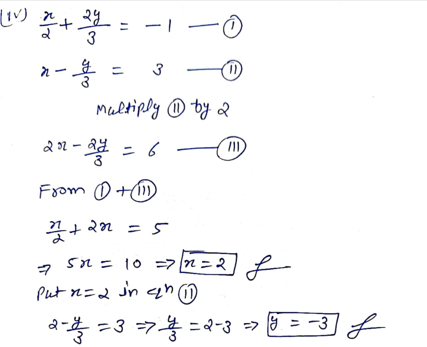Hi Friends and Champs!
In the next exercise, we will solve the questions by the elimination method.
EXERCISE 3.3.
1. Solve the following pair of linear equations by the elimination method and the substitution
method :
(i) x + y = 5 and 2x – 3y = 4
(iii) 3x – 5y – 4 = 0 and 9x = 2y + 7
(ii) 3x + 4y = 10 and 2x – 2y = 2 (iv)
x/y + 2y/3 = -1 and x - y/3 = 3
Solution:
(i) x + y = 5 --------------- (1)
2x – 3y = 4 -------------(2)
Multiply equation (1 ) by 2 in both side,
2x + 2y = 10 ----------------(3)
subtract eq (2) by eq (3)
2x + 2y =10
2x - 3y = 4
- + -
__________
0 + 5y = 6
=> y = 6/5
put value of y in eq (1)
x + 6/5 = 5
x= 5- 6/5
x= 19/5
(ii) 3x + 4y = 10 and 2x – 2y = 2
3x + 4y =10 --------------(1)
2x - 2y = 2 ---------------(2)
multiply eq (2) by 2
4x - 4y =4 -----------------(3)
Add eq (1) and eq (3 )
7x = 14
=> x =2
put x= 2 in eq (2)
2 x 2 - 2y = 2
=> 4 - 2y = 2
=> 2y = 2
=> y = 1
(iii) 3x – 5y – 4 = 0 and 9x = 2y + 7
3x - 5y = 4 -----------------(1)
9x - 2y = 7 ------------------(2)
multiple eq (1) by 3
9x - 15y = 12 ---------------(3)
Subtract eq (2) by eq (3)
-13y = 5
y= - 5/13
multiple eq (1) by 2 and eq (2) by 5
6x - 10y = 8 ---------------(4)
45x-10y = 35 --------------(5)
subtract eq (4) by eq (5)
39x = 27
x= 27/39
=> x=9/13
(iv) x/y + 2y/3 = -1 and x - y/3 = 3
2. Form the pair of linear equations in the following problems, and find their solutions
(if they exist) by the elimination method :
(i) If we add 1 to the numerator and subtract 1 from the denominator, a fraction reduces
to 1. It becomes 1/2
if we only add 1 to the denominator. What is the fraction?
(ii) Five years ago, Nuri was thrice as old as Sonu. Ten years later, Nuri will be twice as
old as Sonu. How old are Nuri and Sonu?
(iii) The sum of the digits of a two-digit number is 9. Also, nine times this number is
twice the number obtained by reversing the order of the digits. Find the number.
(iv) Meena went to a bank to withdraw ` 2000. She asked the cashier to give her
` 50 and ` 100 notes only. Meena got 25 notes in all. Find how many notes of
` 50 and ` 100 she received. (v) A lending library has a fixed charge for the first three days and an additional charge
for each day thereafter. Saritha paid ` 27 for a book kept for seven days, while Susy
paid ` 21 for the book she kept for five days. Find the fixed charge and the charge
for each extra day.
Solution:
Please share your valuable feedback in comment section.





Thanks... very helpful
ReplyDeleteThanks , If you have any issue with some or other chapter's questions , pls let me know. I will try my best to solve your questions.
DeleteGood
ReplyDelete